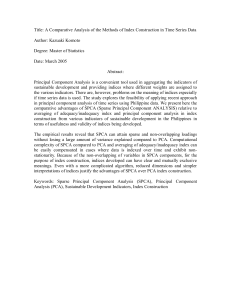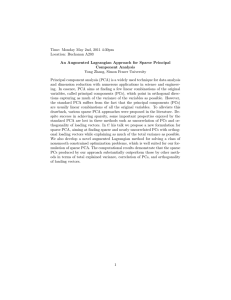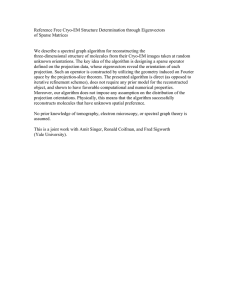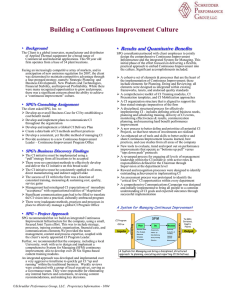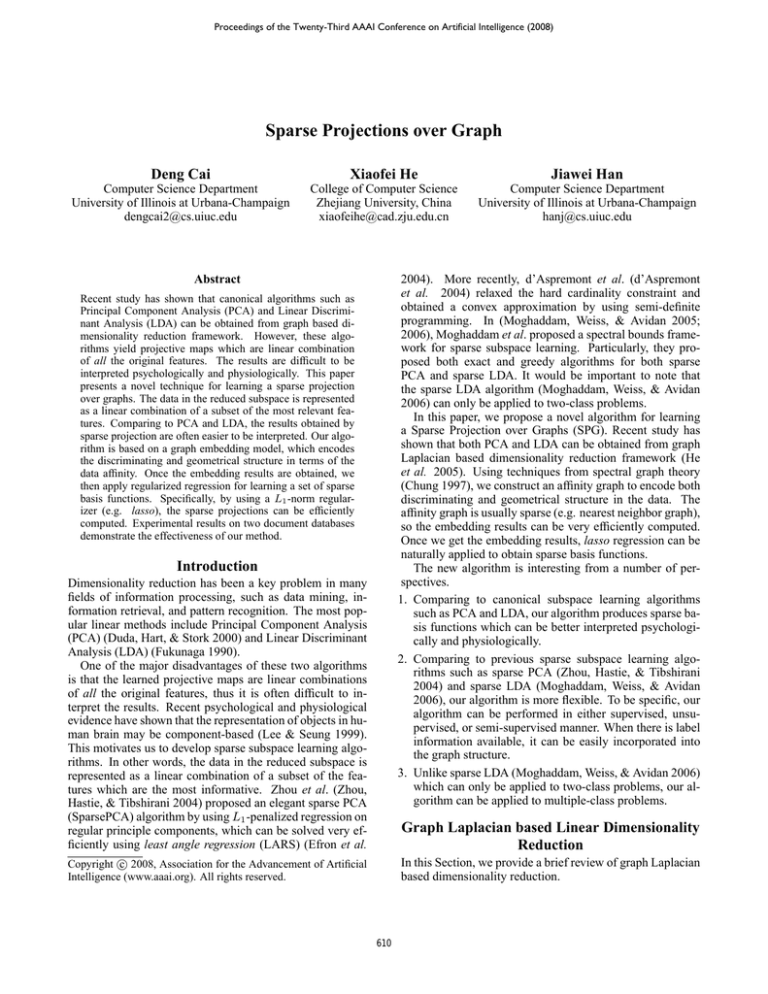
Proceedings of the Twenty-Third AAAI Conference on Artificial Intelligence (2008)
Sparse Projections over Graph
Deng Cai
Xiaofei He
Jiawei Han
Computer Science Department
University of Illinois at Urbana-Champaign
dengcai2@cs.uiuc.edu
College of Computer Science
Zhejiang University, China
xiaofeihe@cad.zju.edu.cn
Computer Science Department
University of Illinois at Urbana-Champaign
hanj@cs.uiuc.edu
Abstract
2004). More recently, d’Aspremont et al. (d’Aspremont
et al. 2004) relaxed the hard cardinality constraint and
obtained a convex approximation by using semi-definite
programming. In (Moghaddam, Weiss, & Avidan 2005;
2006), Moghaddam et al. proposed a spectral bounds framework for sparse subspace learning. Particularly, they proposed both exact and greedy algorithms for both sparse
PCA and sparse LDA. It would be important to note that
the sparse LDA algorithm (Moghaddam, Weiss, & Avidan
2006) can only be applied to two-class problems.
In this paper, we propose a novel algorithm for learning
a Sparse Projection over Graphs (SPG). Recent study has
shown that both PCA and LDA can be obtained from graph
Laplacian based dimensionality reduction framework (He
et al. 2005). Using techniques from spectral graph theory
(Chung 1997), we construct an affinity graph to encode both
discriminating and geometrical structure in the data. The
affinity graph is usually sparse (e.g. nearest neighbor graph),
so the embedding results can be very efficiently computed.
Once we get the embedding results, lasso regression can be
naturally applied to obtain sparse basis functions.
The new algorithm is interesting from a number of perspectives.
1. Comparing to canonical subspace learning algorithms
such as PCA and LDA, our algorithm produces sparse basis functions which can be better interpreted psychologically and physiologically.
2. Comparing to previous sparse subspace learning algorithms such as sparse PCA (Zhou, Hastie, & Tibshirani
2004) and sparse LDA (Moghaddam, Weiss, & Avidan
2006), our algorithm is more flexible. To be specific, our
algorithm can be performed in either supervised, unsupervised, or semi-supervised manner. When there is label
information available, it can be easily incorporated into
the graph structure.
3. Unlike sparse LDA (Moghaddam, Weiss, & Avidan 2006)
which can only be applied to two-class problems, our algorithm can be applied to multiple-class problems.
Recent study has shown that canonical algorithms such as
Principal Component Analysis (PCA) and Linear Discriminant Analysis (LDA) can be obtained from graph based dimensionality reduction framework. However, these algorithms yield projective maps which are linear combination
of all the original features. The results are difficult to be
interpreted psychologically and physiologically. This paper
presents a novel technique for learning a sparse projection
over graphs. The data in the reduced subspace is represented
as a linear combination of a subset of the most relevant features. Comparing to PCA and LDA, the results obtained by
sparse projection are often easier to be interpreted. Our algorithm is based on a graph embedding model, which encodes
the discriminating and geometrical structure in terms of the
data affinity. Once the embedding results are obtained, we
then apply regularized regression for learning a set of sparse
basis functions. Specifically, by using a L1 -norm regularizer (e.g. lasso), the sparse projections can be efficiently
computed. Experimental results on two document databases
demonstrate the effectiveness of our method.
Introduction
Dimensionality reduction has been a key problem in many
fields of information processing, such as data mining, information retrieval, and pattern recognition. The most popular linear methods include Principal Component Analysis
(PCA) (Duda, Hart, & Stork 2000) and Linear Discriminant
Analysis (LDA) (Fukunaga 1990).
One of the major disadvantages of these two algorithms
is that the learned projective maps are linear combinations
of all the original features, thus it is often difficult to interpret the results. Recent psychological and physiological
evidence have shown that the representation of objects in human brain may be component-based (Lee & Seung 1999).
This motivates us to develop sparse subspace learning algorithms. In other words, the data in the reduced subspace is
represented as a linear combination of a subset of the features which are the most informative. Zhou et al. (Zhou,
Hastie, & Tibshirani 2004) proposed an elegant sparse PCA
(SparsePCA) algorithm by using L1 -penalized regression on
regular principle components, which can be solved very efficiently using least angle regression (LARS) (Efron et al.
Graph Laplacian based Linear Dimensionality
Reduction
In this Section, we provide a brief review of graph Laplacian
based dimensionality reduction.
c 2008, Association for the Advancement of Artificial
Copyright Intelligence (www.aaai.org). All rights reserved.
610
n
Suppose we have m data samples {xi }m
i=1 ⊂ R and let
X = (x1 , · · · , xm ). Consider a linear map f (x) = aT x.
The optimal a can be obtained by minimizing the following
loss function:
X
The Algorithm
We adopt graph Laplacian framework to develop an algorithm for learning a sparse projection. Given graph G with
weight matrix W over the data points, we aim to minimize
the following objective function:
2
P
T
T
min
ij a xi − a xj Wij
(1)
subject to
aT XDX T a = 1
card(a) ≤ k
where D is a diagonal matrix whose entries are the row
(or column,
of W . That is,
P since W is symmetric) sums
i
Dii = j Wij . Let yi = (y1i , · · · , ym
) be a projection on
the eigenvector ai . For any i 6= j, it is easy to show that
yi D(yi )T = yj D(yj )T = 1 and yi D(yj )T = 0. This indicates that the projections in the reduced space are weighted
uncorrelated.
The objective function (1) is NP-hard and therefore generally intractable. In the following we describe an efficient
method for solving this optimization problem. By simple
algebraic formulation, it is easy to verify:
X
2
aT xi − aT xj Wij = aT XLX T a
(2)
(aT xi − aT xj )2 Wij
i,j
where W is the weight matrix of a given graph constructed
over all the data points. Both discriminant and geometrical structure can be encoded into the graph and the resulting embedding results found by solving the above objection
function respect the defined graph structure.
It would be interesting to note that recent study has shown
that many popular linear dimensionality reduction algorithms can be derived from the graph Laplacian framework.
Particularly, He et al. have shown that with specially designed graph structure, we can get both PCA and LDA (He
et al. 2005):
Graph structure for PCA
1 1 ··· 1
1 1 ··· 1
W =
... ... . . . ...
1 1 ··· 1
Graph structure
1 for LDA1
· · · m1
m
.1 .
..
..
..
.
1 ···
1
m1
m1
W = 0 ···
0
.
.
··· ···
.
..
.
··· ···
0 ··· ···
ij
0
···
···
0
0
..
.
···
···
···
···
0
···
0
1
mc
···
..
.
···
0
0
..
.
1
mc
0
where the matrix L = D − W is usually called graph Laplacian (Chung 1997). A natural relaxation to this problem is
to first remove the cardinality constraint and solve the following eigenvector problem:
XLX T a = λXDX T a
0
1
mc
..
.
0
0
(3)
T
Once the embedding results yi = a xi are obtained, we can
apply lasso regression to get a sparse transformation vector.
Specifically, let ã be the sparse approximation of a. Thus, ã
can be obtained by minimizing the sum of least squares with
L1 -norm penalty:
n
m 2
X
X
aT xi − ãT xi + β
|ãj |
(4)
min
1
mc
ã
where mi (i = 1, · · · , c) is the number of data points in the
i-th class. Clearly, the PCA graph describes the global geometrical structure, whereas the LDA graph describes the
discriminant structure.
i=1
j=1
which is equivalent to
m n
2
X
X
min
yi − ãT xi + β
|ãj |
ã
Sparse Projection over Graphs
i=1
(5)
j=1
where ãj is the j-th element in ã. Due to the nature of the
L1 -norm penalty, some coefficients ãj ’s will be shrunk to
exact zero if β is sufficiently large. Specifically, for any
given k, there exists β such that the solution of the optimization problem in Eqn. (5) satisfies card(ã) ≤ k (Hastie,
Tibshirani, & Friedman 2001)(Efron et al. 2004). The Least
Angel Regression (LARS) algorithm (Efron et al. 2004) can
be used to efficiently compute the entire solution path (the
solutions with all the possible cardinality on ã) of the problem in Eqn. (5).
One problem still remains. That is, the generalized eigenvector problem (3) is computationally expensive. In order to
reduce the computational complexity, we have the following
theorem:
In this section, we introduce our algorithm for learning a
sparse projection over graphs. We begin with a formal description of the learning problem.
The Problem
The generic problem of linear sparse dimensionality reduction is the following. Given a set x1 , · · · , xm in Rn , find
a transformation matrix A = (a1 , · · · , al ) that maps these
m points to a set of points y1 , · · · , ym in Rl (l ≪ n), such
that yi (= AT xi ) “represents” xi and the cardinality of ai
(i = 1, · · · , l) is less than k, where k(< n) is a suitable integer. The cardinality of a vector is defined as the number of
non-zero entries.
611
Since 1 is a repeated eigenvalue of W , we could just pick any
other c orthogonal vectors in the space spanned by {yk }, and
define them to be our c eigenvectors. The vector of all ones e
is naturally in the spanned space. This vector is useless since
the responses of all the data points are the same. In reality,
we can pick e as our first eigenvector and use Gram-Schmidt
process to get the remaining c − 1 orthogonal eigenvectors.
The vector of all ones can then be removed.
In binary classification case, the above procedure will produce the following embedding vector
Theorem 1 Let y be the eigenvector of the following equation:
Ly = λDy
(6)
If X T a = y, then a is the eigenvector of the eigen-problem
(3) with the same eigenvalue.
Proof We have Ly = λDy. At the left hand side of Eq. (3),
replace X T a by y, thus we have
XLX T a = XLy = XλDy = λXDy = λXDX T a
y=[
Therefore, a is the eigenvector of eigen-problem (3) with the
same eigenvalue λ.
m1
Theorem (1) shows that instead of solving the eigenproblem in Eq. (3), the embedding result y can be directly
obtained by solving Eq. (6). Since the graph is usually specially designed and sparse, the computation can be very efficient.
Once the embedding result y is obtained, we can apply
lasso regression (Hastie, Tibshirani, & Friedman 2001) in
Eqn. (5) to solve the optimization problem (1).
Ly = λDy
(D − W )y = λDy
W y = (1 − λ)Dy = λ′ Dy
The SPG computation involves two steps: responses generation (i.e., calculate the eigenvectors of eigen-problem in Eq.
(7)) and lasso regression.
Two of the most popular graphs are supervised blockdiagonal graph (e.g., LDA) and unsupervised p-nearest
neighbor graph. For the weight matrix W of a blockdiagonal graph, the cost of the first step is mainly the cost
of Gram-Schmidt method, which is O(mc2 ) (Golub & Loan
1996). For a p-nearest neighbor graph, W is sparse and there
are around p non-zero elements in each row of W . The
Lanczos algorithm can be used to efficiently compute the
first l eigenvectors of the eigen-problem in Eqn. (7) within
O(lqmp), where q is the number of iterations in Lanczos
(Golub & Loan 1996).
By using the Least Angel Regression (LARS) algorithm,
the entire solution path (the solutions with all the possible
cardinality on ã) of lasso in Eqn. 5 can be computed in
O(n3 + mn2 ) (Efron et al. 2004). If we require card(a) ≤
k, this cost can be reduced to O(k 3 + mk 2 ) (Efron et al.
2004).
Considering m ≫ c, SPG provides a sparse LDA solution
with O(n3 + mn2 ) complexity. Comparing to the O(n4 +
mn2 ) greedy algorithm described in (Moghaddam, Weiss,
& Avidan 2006), SPG is much more efficient.
(7)
Thus, finding the eigenvectors of the eigen-problem (6) with
respect to the smallest eigenvalue is equivalent to finding the
eigenvectors of eigen-problem (7) with respect to the largest
eigenvalue.
Generally, we need to solve the eigen-problem in Eq. (7)
to get the embedding vectors y’s. Nevertheless, in some
cases, i.e. LDA, the weight matrix W has a block diagonal
structure and there is no need to solve the eigen-problem.
Without loss of generality, we assume that the data points
in {x1 , · · · , xm } are ordered according to their labels. Thus,
W has a block-diagonal structure, as defined in Section
2. Since W is block-diagonal, its eigenvalues and eigenvectors1 are the union of the eigenvalues and eigenvectors of its blocks (the latter padded appropriately with zeros) (Golub & Loan 1996). Let W (t) be the t-th diagonal
(t)
block. That is, W (t) is a mt × mt matrix and Wij = m1t ,
∀i, j. It is straightforward to show that W (t) has eigenvector e(t) ∈ Rmt associated with eigenvalue 1, where
e(t) = [1, 1, · · · , 1]T . Also there is only one non-zero eigenvalue of W (t) because the rank of W (t) is 1. Thus, there
are exactly c eigenvectors of W with the same eigenvalue 1.
These eigenvectors are
yt = [ 0, · · · , 0, 1, · · · , 1, 0, · · · , 0 ]T .
| {z } | {z } P| {z }
i=1
mi
mt
m2
Computational Complexity of SPG
Noticing that L = D − W , we have
P t−1
(9)
This is consistent with the previous well-known result on the
relationship between LDA and regression for a binary problem (Hastie, Tibshirani, & Friedman 2001). The SPG algorithm proposed in this paper extends this relation to multiclass case. Moreover, our approach also establishes the connection between regression and many other graph based subspace learning algorithms, e.g., Locality Preserving Projections (He & Niyogi 2003).
The Eigenvectors of Eigen-problem (6)
⇒
⇒
m −m
−m T
m
,··· ,
,··· ,
,
] .
m
m1 m2
m2
| 1 {z
} |
{z
}
c
i=t+1
Experimental Results
In this section, we investigate the use of our algorithm for
text clustering. The following five methods are compared in
the experiment:
(8)
mi
• Baseline: K-means on the original term-document matrix, which is treated as our baseline.
1
It is easy to check that D = I with the LDA W defined in Section 2. The generalized eigenvectors in Eqn. (7) reduce to ordinary
eigenvectors of W .
• LSI: K-means after Latent Semantic Indexing. LSI is essentially similar to PCA.
612
the content of each cluster is narrowly defined, whereas in
Reuters, documents in each cluster have a broader variety of
content. Moreover, the Reuters corpus is much more unbalanced, with some large clusters more than 200 times larger
than some small ones. In our test, we discarded documents
with multiple category labels, and only selected the largest
30 categories. This left us with 8067 documents in total.
Table 2 provides the statistics of the two document corpora.
Each document is represented as a term frequency (TF)
vector and each vector is normalized to unit. For the purpose
of reproducibility, we provide our algorithms and data sets
used in these experiments at:
http://www.cs.uiuc.edu/homes/dengcai2/Data/data.html
Table 1: Statistics of TDT2 and Reuters corpora.
TDT2 Reuters
No. docs. used
9394
8067
No. clusters used
30
30
Max. cluster size 1844
3713
Min. cluster size
52
18
Med. cluster size
131
45
Avg. cluster size
313
269
Table 2: Statistics of clusters in TDT2 and Reuters corpora.
No. of
clusters (c)
2
3
4
5
6
7
8
9
10
Avg. docs. #
TDT2 Reuters
605
641
939
1099
1180
1401
1660
1101
1650
1360
2255
1794
2557
2602
2725
2840
2987
2488
Avg. terms #
TDT2 Reuters
6011
2486
8342
3979
10102
5030
12773
4594
13042
5168
15423
6766
16761
7980
16943
8538
18842
8137
Evaluation Metric The clustering result is evaluated by
comparing the obtained label of each document with that
provided by the document corpus. Two metrics, the accuracy (AC) and the normalized mutual information metric
(M I) are used to measure the clustering performance (Cai,
He, & Han 2005), (Xu, Liu, & Gong 2003). Given a document xi , let ri and si be the obtained cluster label and the
label provided by the corpus, respectively. The AC is defined as follows:
Pn
δ(si , map(ri ))
AC = i=1
n
• SPCA: K-means after SparsePCA.
• SPG: K-means after SPG.
where n is the total number of documents and δ(x, y) is the
delta function that equals one if x = y and equals zero otherwise, and map(ri ) is the permutation mapping function that
maps each cluster label ri to the equivalent label from the
data corpus. The best mapping can be found by using the
Kuhn-Munkres algorithm (Lovasz & Plummer 1986).
Let C denote the set of clusters obtained from the ground
truth and C ′ obtained from our algorithm. Their mutual information metric M I(C, C ′ ) is defined as follows:
• NMF: Nonnegative Matrix Factorization-based clustering
(Xu, Liu, & Gong 2003)). The weighted NMF-based
clustering method is a recently proposed algorithm which
has been shown to be very effective in document clustering (Xu, Liu, & Gong 2003).
Note that, our SPG algorithm needs to construct a graph over
the documents. In this experiment, we set the parameter p
(number of nearest neighbors) to 7.
All these algorithms are tested on the TDT2 corpus2 , and
the Reuters-21578 corpus3 . These two document corpora
have been among the ideal test sets for document clustering purposes because documents in the corpora have been
manually clustered based on their topics and each document has been assigned one or more labels indicating which
topic/topics it belongs to.
The TDT2 corpus consists of data collected during the
first half of 1998 and taken from 6 sources, including 2
newswires (APW, NYT), 2 radio programs (VOA, PRI) and
2 television programs (CNN, ABC). It consists of 11201 ontopic documents which are classified into 96 semantic categories. In this experiment, those documents appearing in
two or more categories were removed, and only the largest
30 categories were kept, thus leaving us with 9,394 documents in total.
Reuters corpus contains 21578 documents which are
grouped into 135 clusters. Compared with TDT2 corpus,
the Reuters corpus is more difficult for clustering. In TDT2,
M I(C, C ′ ) =
X
p(ci , c′j ) · log2
ci ∈C,c′j ∈C ′
p(ci , c′j )
p(ci ) · p(c′j )
where p(ci ) and p(c′j ) are the probabilities that a document
arbitrarily selected from the corpus belongs to the clusters
ci and c′j , respectively, and p(ci , c′j ) is the joint probability
that the arbitrarily selected document belongs to the clusters
ci as well as c′j at the same time. In our experiments, we use
the normalized mutual information M I as follows:
M I(C, C ′ ) =
M I(C, C ′ )
max(H(C), H(C ′ ))
where H(C) and H(C ′ ) are the entropies of C and C ′ , respectively. It is easy to check that M I(C, C ′ ) ranges from
0 to 1. M I = 1 if the two sets of clusters are identical, and
M I = 0 if the two sets are independent.
Results The evaluations were also conducted with different number of clusters, ranging from 2 to 10. For each
given cluster number c, 50 tests were conducted on different randomly chosen categories, and the average performance was computed over these 50 tests (except the 30 cluster case). For each test, K-means algorithm was applied 10
2
Nist Topic Detection and Tracking corpus at
http://www.nist.gov/speech/tests/tdt/tdt98/index.htm
3
Reuters-21578 corpus is at
http://www.daviddlewis.com/resources/testcollections/reuters21578/
613
c
2
3
4
5
6
7
8
9
10
Avg.
Baseline
97.7
88.4
85.7
82.4
79.0
74.5
70.1
72.3
69.2
79.9
Table 3:
Accuracy (%)
LSI SPCA SPG
98.7
99.2
99.9
91.0
94.3
99.7
87.4
90.8
99.5
81.7
85.1
98.8
79.0
83.3
98.5
72.4
76.7
98.1
68.1
71.8
97.1
70.6
73.6
96.5
66.7
71.0
95.0
79.5
82.9
98.1
Clustering performance on TDT2
Normalized Mutual Information (%)
NMF Baseline LSI SPCA SPG NMF
99.2
91.3
94.7
96.6
98.4 96.6
95.7
81.5
84.3
88.1
97.4 90.7
92.4
82.0
82.3
85.2
96.9 87.7
92.2
79.0
77.7
79.9
95.1 86.6
88.0
78.1
78.0
80.4
95.5 84.2
83.1
74.5
73.2
75.0
94.1 79.9
79.7
71.5
69.4
71.2
93.3 76.2
84.8
75.1
73.9
74.6
92.4 81.8
81.5
73.1
71.3
72.6
90.8 78.3
88.5
78.5
78.3
80.4
94.9 84.7
95
Normalized mutual information
95
90
Accuracy
85
80
75
Baseline
LSI
SPCA
SPG
NMF
70
65
60
Sparsity (%)
SPCA SPG
98.3
98.5
99.4
99.3
99.5
99.3
99.8
99.5
99.3
99.3
99.3
99.2
99.4
99.3
99.6
99.7
99.8
99.6
99.4
99.3
0
50
100
Cardinality (k)
150
90
85
80
75
65
60
200
Baseline
LSI
SPCA
SPG
NMF
70
0
50
100
Cardinality (k)
150
200
Figure 1: Accuracy and normalized mutual information vs. cardinality on TDT2 corpus
times with different start points and the best result in terms
of the objective function of K-means was recorded. After
LSI, SparsePCA, or SPG, how to determine the dimensionality of the subspace is still an open problem. In this experiment, we keep c dimensions for all the three algorithms as
suggested by previous study (Cai, He, & Han 2005).
We show the performance change with the cardinality of
basis functions in SparsePCA and SPG. As can be seen, the
best performance is obtained with relatively small cardinality.
in our future work. First, in this work, we use the simple
nearest neighbor graph to encode both discriminating and
geometrical structure of the data manifold. However, there
is no reason to believe this is the only or the best way to
construct the affinity graph. Second, our algorithm is linear,
but it also can be performed in reproducing kernel Hilbert
space (RKHS) which gives rise to nonlinear maps. The performance of SPG in RKHS needs to be further examined.
Conclusions
The work was supported in part by the U.S. National Science Foundation NSF IIS-05-13678, NSF BDI-05-15813
and MIAS (a DHS Institute of Discrete Science Center
for Multimodal Information Access and Synthesis). Any
opinions, findings, and conclusions or recommendations expressed here are those of the authors and do not necessarily
reflect the views of the funding agencies.
Acknowledgment
In this paper, we described a subspace learning algorithm
called Sparse Projection over Graphs. We construct an affinity graph which can encode both discriminant and geometrical structure in the data. The sparse projections can be
obtained by solving an optimization problem. We have also
suggested an approach for solving this optimization problem
by using techniques from spectral graph theory and lasso regression. Several experiments on document clustering were
carried out on two databases. Our method was shown to
outperform both PCA, LDA, and sparse PCA.
Several questions remains unclear and will be investigated
References
Cai, D.; He, X.; and Han, J. 2005. Document clustering
using locality preserving indexing. IEEE Transactions on
Knowledge and Data Engineering 17(12):1624–1637.
614
c
2
3
4
5
6
7
8
9
10
Avg.
Baseline
83.2
73.8
66.6
62.4
60.2
52.3
47.0
42.1
45.6
59.2
Table 4: Clustering performance on Reuters
Accuracy (%)
Normalized Mutual Information (%)
LSI SPCA SPG NMF Baseline LSI SPCA SPG NMF
83.9
83.3
88.2 84.0
49.0
51.4
48.3
49.6 45.9
73.6
75.3
84.6 76.7
48.1
48.6
48.5
48.3 46.3
67.7
67.9
77.9 71.2
47.1
48.0
47.6
52.1 47.2
61.7
62.5
69.1 67.5
48.1
48.7
49.3
52.2 49.6
63.2
62.0
62.4 65.1
50.2
52.1
51.2
49.8 49.4
53.4
53.6
67.7 59.0
44.3
44.7
44.5
53.9 44.2
48.4
47.9
56.9 54.0
41.1
41.4
40.3
45.5 39.3
42.5
42.7
54.9 51.8
36.9
36.7
36.2
43.2 36.8
44.4
44.8
55.1 52.3
42.3
41.2
41.0
47.3 40.7
59.9
60.0
68.5 64.6
45.2
45.9
45.2
49.1 44.4
50
Normalized mutual information
70
65
Accuracy
Sparsity (%)
SPCA SPG
98.8
99.2
95.7
95.5
97.8
96.0
96.3
95.9
96.1
97.5
97.0
97.0
98.0
97.7
97.9
97.7
97.9
97.5
97.3
97.1
60
Baseline
LSI
SPCA
SPG
NMF
55
50
0
50
100
Cardinality (k)
150
48
46
44
42
40
38
200
Baseline
LSI
SPCA
SPG
NMF
0
50
100
Cardinality (k)
150
200
Figure 2: Accuracy and normalized mutual information vs. cardinality on Reuters corpus
Chung, F. R. K. 1997. Spectral Graph Theory, volume 92
of Regional Conference Series in Mathematics. AMS.
d’Aspremont, A.; Chaoui, L. E.; Jordan, M. I.; and Lanckriet, G. R. G. 2004. A direct formulation for sparse PCA
using semidefinite programming. In Advances in Neural
Information Processing Systems 17.
Duda, R. O.; Hart, P. E.; and Stork, D. G. 2000. Pattern
Classification. Hoboken, NJ: Wiley-Interscience, 2nd edition.
Efron, B.; Hastie, T.; Johnstone, I.; and Tibshirani,
R. 2004. Least angle regression. Annals of Statistics
32(2):407–499.
Fukunaga, K. 1990. Introduction to Statistical Pattern
Recognition. Academic Press, 2nd edition.
Golub, G. H., and Loan, C. F. V. 1996. Matrix computations. Johns Hopkins University Press, 3rd edition.
Hastie, T.; Tibshirani, R.; and Friedman, J. 2001. The
Elements of Statistical Learning: Data Mining, Inference,
and Prediction. New York: Springer-Verlag.
He, X., and Niyogi, P. 2003. Locality preserving projections. In Advances in Neural Information Processing
Systems 16. Cambridge, MA: MIT Press.
He, X.; Yan, S.; Hu, Y.; Niyogi, P.; and Zhang, H.-J. 2005.
Face recognition using laplacianfaces. IEEE Transactions
on Pattern Analysis and Machine Intelligence 27(3):328–
340.
Lee, D. D., and Seung, H. S. 1999. Learning the parts
of objects by non-negative matrix factorization. Nature
401:788–791.
Lovasz, L., and Plummer, M. 1986. Matching Theory.
North Holland, Budapest: Akadémiai Kiadó.
Moghaddam, B.; Weiss, Y.; and Avidan, S. 2005. Spectral
bounds for sparse PCA: Exact and greedy algorithms. In
Advances in Neural Information Processing Systems 18.
Moghaddam, B.; Weiss, Y.; and Avidan, S. 2006. Generalized spectral bounds for sparse LDA. In ICML ’06: Proceedings of the 23rd international conference on Machine
learning, 641–648.
Xu, W.; Liu, X.; and Gong, Y. 2003. Document clustering based on non-negative matrix factorization. In Proc.
2003 Int. Conf. on Research and Development in Information Retrieval (SIGIR’03), 267–273.
Zhou, H.; Hastie, T.; and Tibshirani, R. 2004. Sparse principle component analysis. Technical report, Statistics Department, Stanford University.
615



